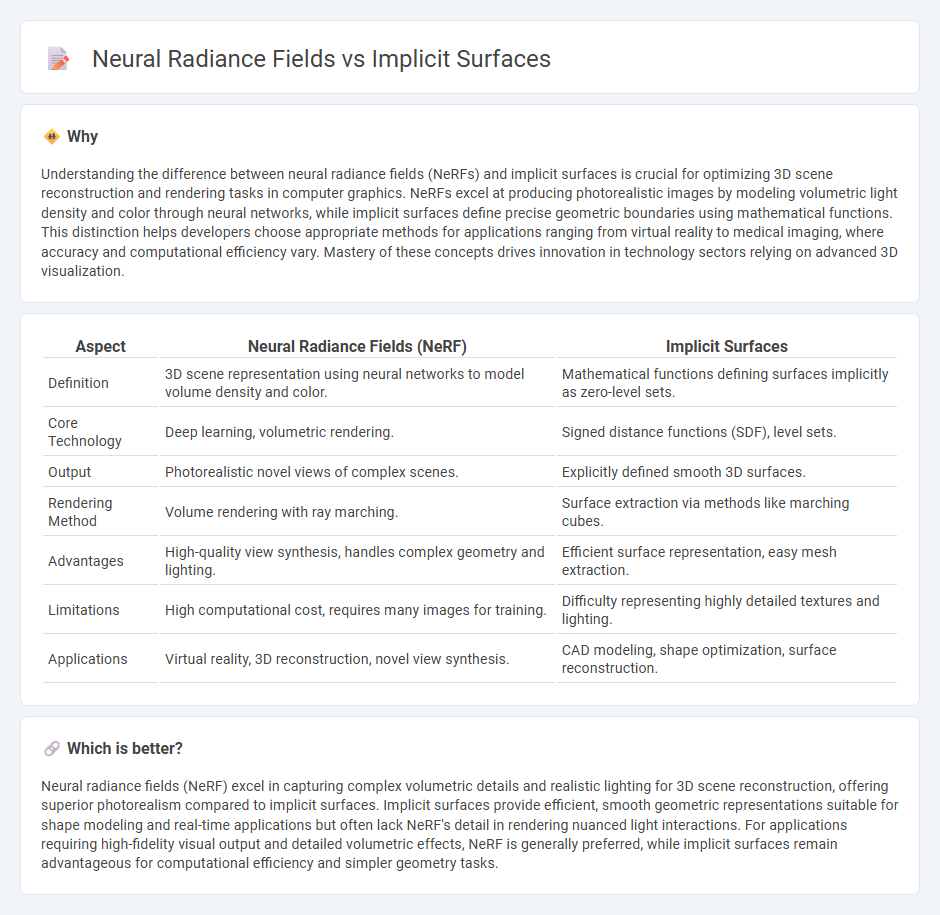
Neural Radiance Fields (NeRF) represent scenes by modeling volume density and radiance to generate photorealistic 3D reconstructions, while implicit surfaces use mathematical functions to define continuous surfaces without explicit mesh representations. NeRF excels in capturing complex light interactions and fine details through volumetric rendering, whereas implicit surfaces emphasize smooth geometry and efficient shape manipulation. Explore the differences in performance and applications to understand which technology best suits your 3D modeling needs.
Why it is important
Understanding the difference between neural radiance fields (NeRFs) and implicit surfaces is crucial for optimizing 3D scene reconstruction and rendering tasks in computer graphics. NeRFs excel at producing photorealistic images by modeling volumetric light density and color through neural networks, while implicit surfaces define precise geometric boundaries using mathematical functions. This distinction helps developers choose appropriate methods for applications ranging from virtual reality to medical imaging, where accuracy and computational efficiency vary. Mastery of these concepts drives innovation in technology sectors relying on advanced 3D visualization.
Comparison Table
| Aspect | Neural Radiance Fields (NeRF) | Implicit Surfaces |
|---|---|---|
| Definition | 3D scene representation using neural networks to model volume density and color. | Mathematical functions defining surfaces implicitly as zero-level sets. |
| Core Technology | Deep learning, volumetric rendering. | Signed distance functions (SDF), level sets. |
| Output | Photorealistic novel views of complex scenes. | Explicitly defined smooth 3D surfaces. |
| Rendering Method | Volume rendering with ray marching. | Surface extraction via methods like marching cubes. |
| Advantages | High-quality view synthesis, handles complex geometry and lighting. | Efficient surface representation, easy mesh extraction. |
| Limitations | High computational cost, requires many images for training. | Difficulty representing highly detailed textures and lighting. |
| Applications | Virtual reality, 3D reconstruction, novel view synthesis. | CAD modeling, shape optimization, surface reconstruction. |
Which is better?
Neural radiance fields (NeRF) excel in capturing complex volumetric details and realistic lighting for 3D scene reconstruction, offering superior photorealism compared to implicit surfaces. Implicit surfaces provide efficient, smooth geometric representations suitable for shape modeling and real-time applications but often lack NeRF's detail in rendering nuanced light interactions. For applications requiring high-fidelity visual output and detailed volumetric effects, NeRF is generally preferred, while implicit surfaces remain advantageous for computational efficiency and simpler geometry tasks.
Connection
Neural radiance fields (NeRFs) represent 3D scenes by encoding volumetric radiance information in neural networks, while implicit surfaces define shapes through continuous functions capturing surface geometry. Both technologies leverage differentiable representations to reconstruct high-fidelity 3D models from sparse input data, enabling advancements in computer vision and graphics. The integration of NeRFs with implicit surface techniques enhances scene rendering accuracy and efficiency, crucial for applications like virtual reality and autonomous navigation.
Key Terms
Signed Distance Function (SDF)
Implicit surfaces, represented through Signed Distance Functions (SDF), define shapes by mapping spatial points to the shortest distance from the surface, enabling precise geometry and smooth surface reconstruction. Neural Radiance Fields (NeRF) extend volumetric rendering by encoding scene radiance and density for realistic view synthesis but lack direct geometric guarantees compared to SDF. Explore how combining SDF with neural techniques advances 3D reconstruction and rendering performance.
Volumetric Rendering
Implicit surfaces represent 3D shapes using mathematical functions that define boundary surfaces, while neural radiance fields (NeRFs) model volumetric radiance and density to generate photorealistic images from novel viewpoints. Volumetric rendering in NeRFs integrates light absorption and emission through dense neural networks, producing highly detailed and view-dependent effects, outperforming traditional implicit surface methods in capturing complex light interactions. Explore the latest advancements in volumetric rendering techniques and their applications in computer graphics and virtual reality.
Neural Network Representation
Neural Network Representation in implicit surfaces uses deep learning to encode 3D shapes as continuous functions, enabling smooth, high-resolution reconstructions from sparse data. Neural Radiance Fields (NeRF) extend this concept by modeling scene volumetric density and color, allowing photorealistic novel view synthesis through optimized neural networks. Explore the latest advancements in Neural Network Representation to fully understand the potential and applications of these technologies.
Source and External Links
Implicit Surfaces that Interpolate - Computer Graphics - Implicit surfaces are often created by summing radial basis functions and can be defined to interpolate points precisely, producing smooth shapes via solving a matrix system rather than manual weight specification.
Implicit surface - Wikipedia - An implicit surface is the set of zeros of a function of three variables, where the surface can be understood as all points satisfying \(F(x,y,z) = 0\), and can represent complex shapes via formulas such as distance products or blends between surfaces.
Implicit Surfaces Jules Bloomenthal Unchained Geometry - Implicit surfaces define two-dimensional geometric shapes in three-dimensional space through equations that produce surfaces as level sets of a scalar field, analogous to surface contours in 2D color gradients or densities in volumes.
 dowidth.com
dowidth.com